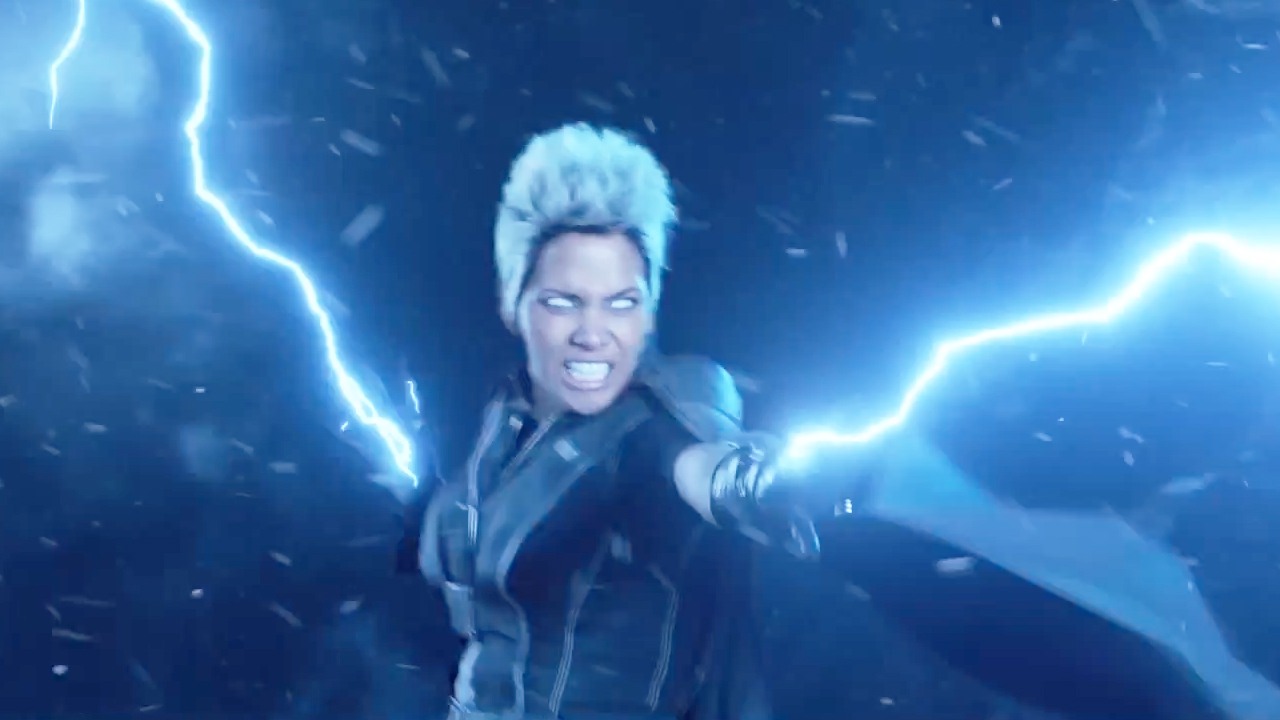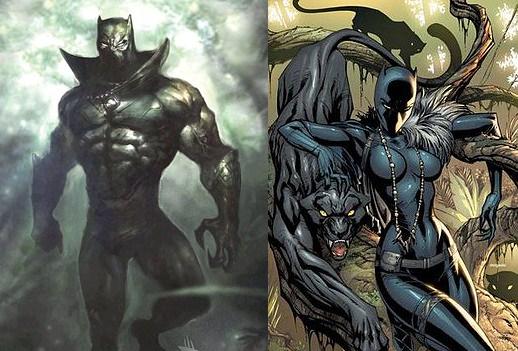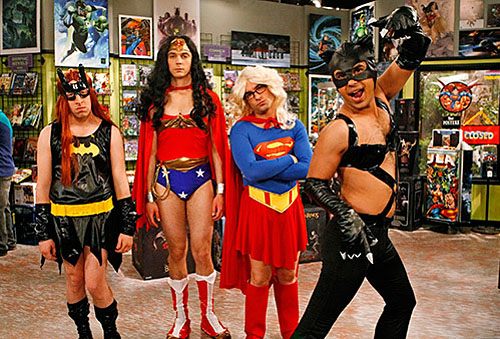This guest post written by Sara Century appears as part of our theme week on Superheroines.
Originally introduced in 1975, Storm is widely celebrated as the first Black female superhero. Although The Butterfly in comic magazine Hell-Rider is technically the first. While the first Black male recurring character in a Marvel or DC comic predates Storm by 12 years, it’s impossible to minimize the importance of even her first appearance, especially as she is the first Black woman “to play either a major or supporting role” in Marvel or DC comics. To dissect how the X-Men film franchise fails the previously established iconic character of Storm, we must first view her other incarnations.
In the comics, Storm (Ororo Munroe) is a mutant who has the power of weather control and the ability to fly on wind currents and control lightning. She has been a recurring character in the X-Men for the last 41 years. Storm is introduced as a girl who was orphaned at age six, thereby thrown into a world where she had to fend for herself. She fell in with a group of children who were also pickpockets, and she lived in Cairo until she set out on her own. Discovering her mutant powers around puberty, she was worshiped as an African goddess by what amounted to being a fairly problematic depiction of rural Africans before being discovered by Xavier. At that time, she joined the X-Men.
At first a serene pacifist, life with the X-Men forced her to encounter multiple ethical quandaries. She grew slowly more comfortable with violence, leading into the famous storyline in which she fights Callisto of the Morlocks, kills her, claims leadership of the Morlocks, completely forgets about them, and ultimately returns leadership to turns-out-not-THAT-dead Callisto. There’s a lot going on in that storyline, but it did give us punk Storm. Disavowed by the costume’s designer Paul Smith as “a bad joke that went too far,” he obviously has no grasp of how that look more than anything else ignited an undying love for Storm in artistic, queer, and feminist subcultures that lasts to this very day. She led the team even after she temporarily lost her powers, up until she took a brief hiatus to hook up with a character named Forge in one of the better early Storm stories, “Lifedeath” and “Lifedeath II.”
The 1990s saw Storm’s development meander under the traditionally listless direction of writers like Scott Lobdell, culminating in a marriage between her and Black Panther that was severely out-of-character for them both. The move was another example of the common mistake comic book companies make, where they think that marrying one of their most powerful female characters to an established male character and making her more or less his sidekick/wife will make women want to read comics. Sidenote: it pretty much unfailingly doesn’t. Black Panther annulled their marriage behind her back, Marvel lost it’s only Black couple, and Storm rejoined the X-Men.
Importantly, and seldom mentioned, Storm is one of the X-Men who shows the greatest ability to change her methods of operation over time; Storm’s versatility sets her apart. In comparison with other female comic book characters, whose moments of growth often come off as stilted and out of character, Storm developed into a completely different person via a logical chain of events. Writers used her fear of enclosed spaces for years as her “kryptonite,” but in recent years, we see that Storm is no longer afraid to be trapped, having undergone about a decade of therapy to deal with the problem. She mentored the X-Men character besides herself that is most known for her queer subtext, aka Kitty Pryde. When Kitty reacted negatively to her punk look, Storm struggled until she found a way to reconnect with her. Storm went to the desert to find herself again after she lost her powers, fell in love with Forge, and then went to Japan and had a fling with a woman named Yukio when things didn’t work out. She lost her powers, and yet remained the leader of the X-Men. She was queer-coded for decades, and finally Marvel writers admitted to her bisexuality in the last couple of years. She is consistently one of the few characters in the X-Men universe that examines herself with any kind of objectivity.

Because the character has existed in multiple different mediums under the dictates of dozens if not hundreds of different creators in her time, there have been multiple takes on her. The version of Storm in the animated television series X-Men that ran from 1992 to 1997 shared few similarities with Storm in the comics. Rather than the street tough child that became a goddess and then an X-Man like in the comic, in the animated series, while a similar background remained, writers played up Storm’s trauma more than the skills she learned as a thief on the streets of Cairo. I believe it was this early on that the image of Storm in public consciousness began to go awry. Don’t misunderstand, I love animated TV series Storm. Her theatrical nature is absolutely true to the comics, and it’s one of her most important traits; every sentence she speaks is a declaration of her awe-inspiring power. Even though I tend to sort of chuckle at the melodrama in her grandiose, booming voice, it is consistent with everything I love about the character. However, in the animated series, Storm’s only settings are 1 or 11, there is no mid-point. Even the seemingly casual sentence, “I’ll meet you at the monorail,” becomes “I SHALL MEET YOU – AT THE MONORAAAAIL!” She’s great, but she lacks in human characteristics, and appears as larger than life in even the most relaxed contexts. She’s either yelling or she’s asleep, there is no third option.
In the 2000s animated television series, X-Men: Evolution, Storm is portrayed as a teacher, older than most of the other X-Men, with the exceptions of Professor Xavier, Beast, and Wolverine. In the show, she is the aunt of Spyke, and the recruiter of new X-Men, which puts her in a supporting role. This is a Storm based more closely to her original version, and not the current comic book form. She was not the Storm that stabbed Callisto, led the Morlocks, or married Black Panther, but, rather, simply a teacher at the Xavier Institute, and thereby just so happens to occasionally be involved in skirmishes with supervillains. Storm is authoritarian and even disciplinarian, but, consistent with the comics, she is also the voice of reason.
Famously, the X-Men films have been the worst to the character, treating her as a B-lister. Played by Halle Berry in X-Men, X-Men 2 (X2), X-Men: The Last Stand, and X-Men: Days of Future Past, thus far her film version’s most memorable moment is regrettably the universally cringe-inducing line, “Do you know what happens when a toad gets struck by lightning? … The same thing that happens to everything else.” The context for the line is worse, as it occurs immediately after getting beaten up by the notoriously useless villain Toad, and before getting stabbed by Wolverine as shapeshifter Mystique has taken her form. Halle Berry’s time as the focal point in all the fight scenes of the X-Men franchise combined clocks in at around two minutes of screen time, most of which is spent slowly levitating while her eyes change color. Her role in X-Men 2 is essentially to empathetically listen to Nightcrawler talk about his problems.
To me, this is where the X-Men films utterly fail Storm as a character. While her comic form is definitely a sympathetic and understanding person, more importantly, she is a warrior trained in hand-to-hand combat, an orphan, a divorcee, a Black woman in a leadership role on a team of mostly white men, a wife, a mentor, and an activist. I don’t believe that the movies have to follow the comic to the letter, but I don’t feel like I’m going that far out on a limb to say that any attempts to add even just one of these facets to Storm’s movie persona would be deeply appreciated by X-Men fans. That is to say, I hope that X-Men: Apocalypse will give Storm a better turn, but likewise I feel my skepticism is warranted, given the previous history of the franchise neglecting the awesomeness of all of its female characters, Storm most notably of all.
References:
Born to the Queen: Why Can’t the X-Men Movies Capture the Majesty of Storm
Storm and the X-Men as Racial Projects
Sara Century is a multimedia performance artist, and you can follow her work at saracentury.wordpress.com.



























